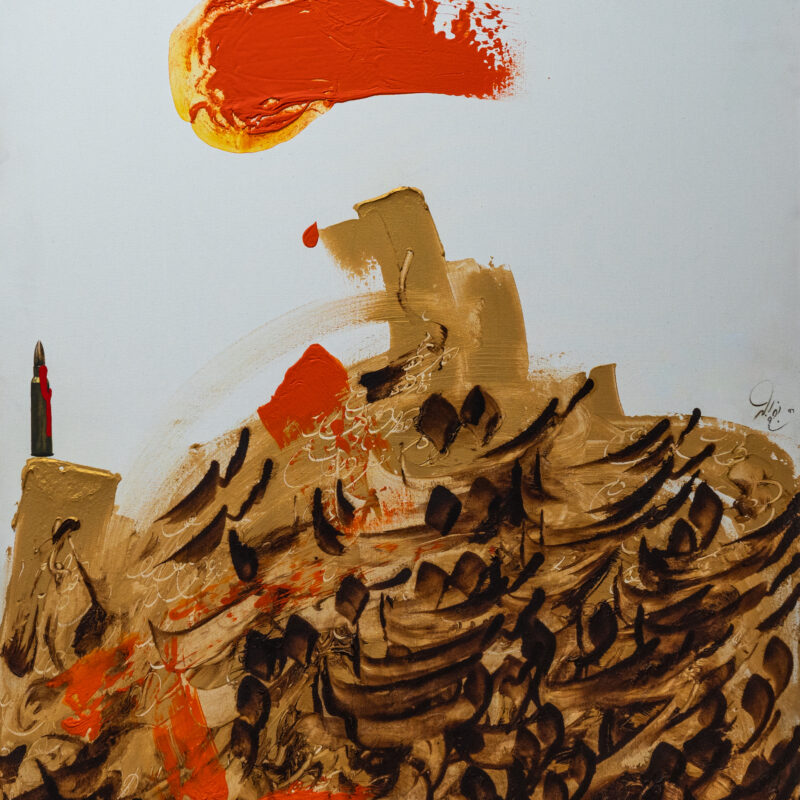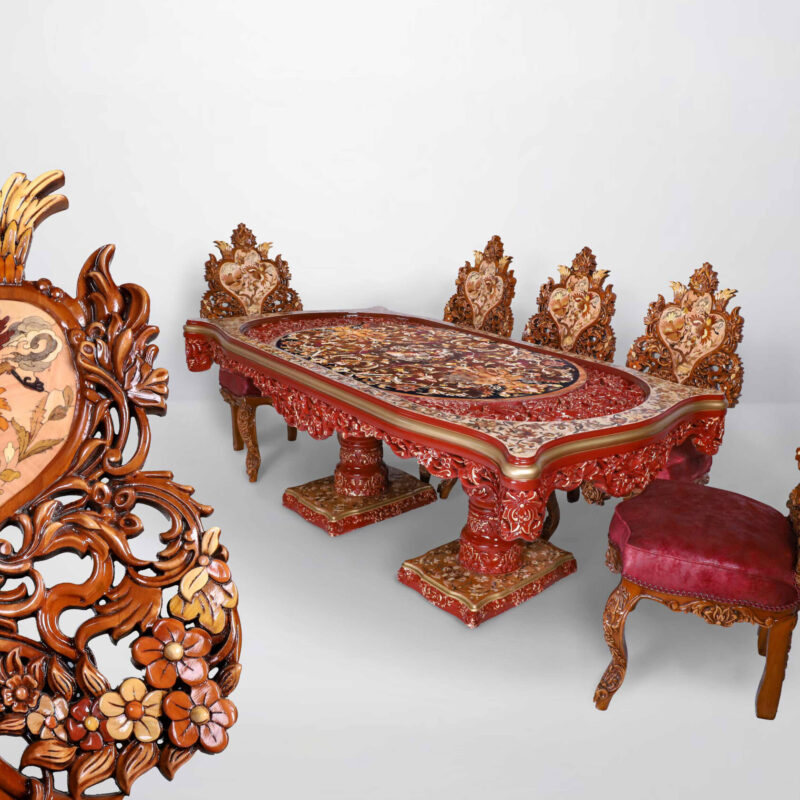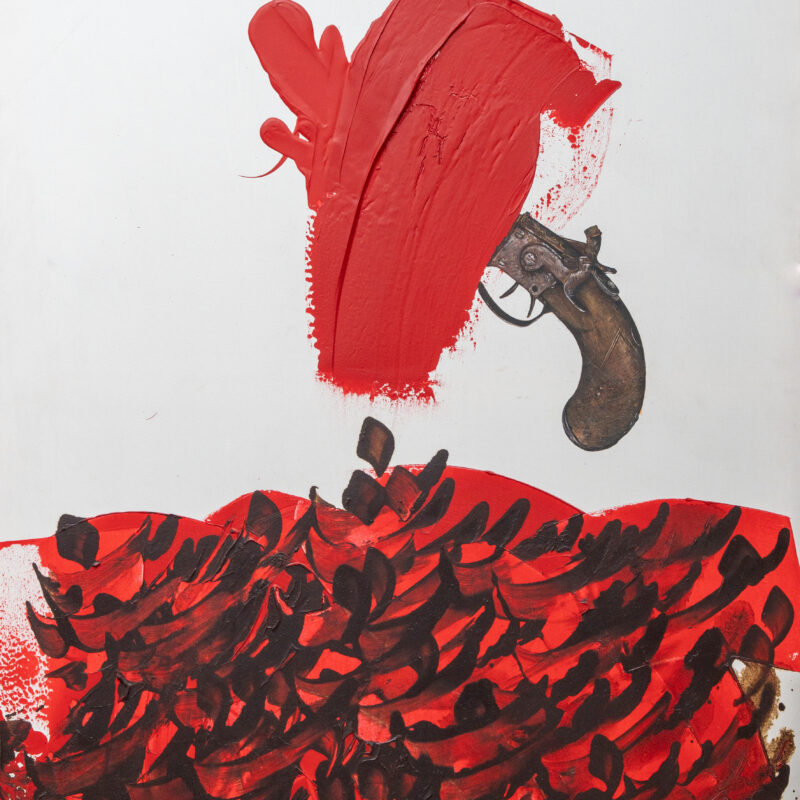"Ryton'un Tozlu Sırları"
- Bir çalışma Usta Ahmad Najafafi “Ryton'un Tozlu Sırları” resmi Usta Ahmad Najafi'nin eşsiz bir başyapıtı, Eski İran tarihini harmanlamak, felsefe, ve olağanüstü hassasiyet ve zarafetle sanat. Bu sanat eseri, ölçüm 150 X 110 CM ve ile yaratıldı Ahşapta yağlı boya ve altın, İran tarihini ve kimliğini güzel bir şekilde sembolize ediyor.
Mavi Rhyton, Keçinin kafasıyla, resmin bir parçasını oluşturan , Achaemenid dönemine dayanıyor ve şu anda ünlü küresel müzelerde korunuyor. Usta Ahmad Najafi, bu çok mavi Rhyton'dan keçinin başı ile ilham aldı, Tarihsel detaylara özellikle dikkat etmek. Mavi Rhyton'a ek olarak , Kan lekeli sayfaların kullanımı ve canlı renkler gibi diğer unsurlar, parçaya derinlik ve sanatsal özgünlük katar.
Bir Dansçı, kırmızı pantolonlu mavi kıyafetlerle tasvir edildi, gizemli bir arka plana karşı duruyor. Siyah, Türlü çizgiler ve altın yaprak kullanımı, Diğer detaylarla birlikte, resme ek cazibe ve anlam ver. “Ryton'un Tozlu Sırları” sadece bir sanat eseri değil, aynı zamanda eski İran tarihi ve kültürünün bir anlatısıdır. Bu resim sadece sanatsal olarak değil, felsefi olarak da değerlidir., Gelecek nesiller için tarihsel ve sanatsal eserlerin korunması, sürekli çabalar ve dikkatli dikkat gerektirirken. Parça, insanlığın kültürel ve sanatsal mirasını korumanın önemini hatırlatıyor, birçok kişinin kanıyla korunan, ve değerlerini çeşitli tehditlere karşı korumaya devam ediyor. Bu resim, Sanatı Birleştirme, tarih, ve felsefe, sanat koleksiyoncuları için ideal bir seçimdir, özel alıcılar, ve saraylarının ihtişamı için benzersiz işler arayanlar. Ek olarak, Usta Ahmad Najafi'nin İran tarihi ve mirası için sahip olduğu saygıyı yansıtır, Bu sanatsal yaratım yoluyla güzelliğini ve anlamını gelecek nesillere aktarmaya çalışmış. Bu eşsiz resim için dikkate alınabilecek yönler aşağıdadır:
1.Ekonomik yön: Büyük boyutları ve altın ve yağlı boyalar gibi değerli malzemelerin kullanımı nedeniyle, Bu parçanın üretim maliyeti yüksek. Ekonomik açıdan, Bu resim sanat pazarında pahalı olarak kabul edilir ve benzersiz ve değerli çalışmalar arayan sanat koleksiyoncularını ve varlıklı bireyleri çekecektir.. Üstelik, eklenen
Otantik ve tarihsel olarak önemli sanatın değeri zamanla artabilir. Bu resim, galerilerde ve uluslararası sergilerdeki sanat satışları için de uygundur, Satıcılar ve galeriler için potansiyel olarak önemli kâr elde etmek.
2. Tarihsel yön: “Ryton'un Tozlu Sırları” resmi eski İran tarihini ifade ediyor, özellikle akaemenid dönemi, Ve bu perspektiften, İran tarihi ve kültürüyle ilgilenenler için büyük bir değere sahiptir., Müzeler ve kültürel kurumlar. .
Resimde gösterilen keçi kafası olan mavi Rhyton, Achaemenid döneminin önde gelen eserlerinden biridir, Ve resmin kendisi İran’ın kültürel ve tarihi mirasının bir parçası. Öyleyse, Bu çalışma benzersiz bir tarihsel belge olarak kabul edilebilir.
3. Felsefi yön: NFelsefi olarak, Resim, kültürel ve sanatsal mirasın korunması ve sürdürülmesi gibi derin kavramları ele alıyor, ve bunu gelecek nesiller için yapmanın önemi. Ek olarak, belirli renklerin kullanımı, altın yaprak, Ve mavi Rhyton, titiz detaylarla birlikte, İran kültürel ve tarihsel kimliğinin önemini sembolize edin. Sanat eserinin arkasındaki felsefe, kültürlerin hayatta kalması ve çeşitli tehditlere karşı korunması konusuna işaret edebilir. Bu kavramlar resme daha fazla derinlik sağlar, onu sadece sanatsal bir parçadan kültürel bir mesaj taşıma aracına dönüştürmek.
4. Sanatsal yön: Sanatsal bir bakış açısından, Bu resim, farklı teknikleri ustaca birleştirir, yağlı boya kullanımı gibi, altın yaprak, ve tarihsel detaylara dikkat. Usta Ahmad Najafafi, Renk ve form karışımı sayesinde, estetik açıdan çekici ve görsel olarak büyüleyici bir sanat eseri yarattı. Tarihsel detayların modern sanatsal ve felsefi unsurlarla birleşimi bu tabloyu eşsiz bir sanatsal yaratıma dönüştürdü.
5. Gelir ve yatırım yönü (Koleksiyonerler ve galeriler için): Koleksiyoncular ve sanat galerileri için, Bu iş, Tarihsel ve sanatsal değeri ve benzersizliği nedeniyle, mükemmel bir yatırım seçeneğidir. Tarihsel destekle zengin kültürlere doğrudan bağlı sanat eserleri genellikle sanat pazarında yüksek değere sahiptir. Eşsiz özellikleri göz önüne alındığında, Bu resim gelecekte fiyatta önemli bir artış görebilir, çünkü sadece sanatsal olarak çekici değil, aynı zamanda İran'ın tarihini ve kültürünü de temsil ediyor, potansiyel uzun vadeli bir yatırım yapmak.
6. Küratörlük pazarında satışlar (galeriler ve sergiler için): Galeriler ve küratörler bu sanat eserini özel İran sanat sergilerinde ve hatta uluslararası sanat gösterilerinde sergileyebilir. Tarihi güzel bir şekilde birleştiren işler, felsefe, ve sanat genellikle özel sergilerde iyi karşılanmaktadır. Eşsiz özellikleri nedeniyle, Bu resim, özel sanat çevreleri ve izleyiciler arasında önemli bir pazar çekebilir.
7. Halk için satışlar: Bu tablo, fiyat açısından genel halk için ulaşılamaz olsa da, Tarihsel ve kültürel öneme sahip sanat arayanlar için hala ilham verici bir örnek olarak hizmet edebilir. Ek olarak, Sanat meraklılarının tadını çıkarmasına izin vermek için satılık sanat eserinin daha küçük versiyonları veya baskıları sunulabilir.






